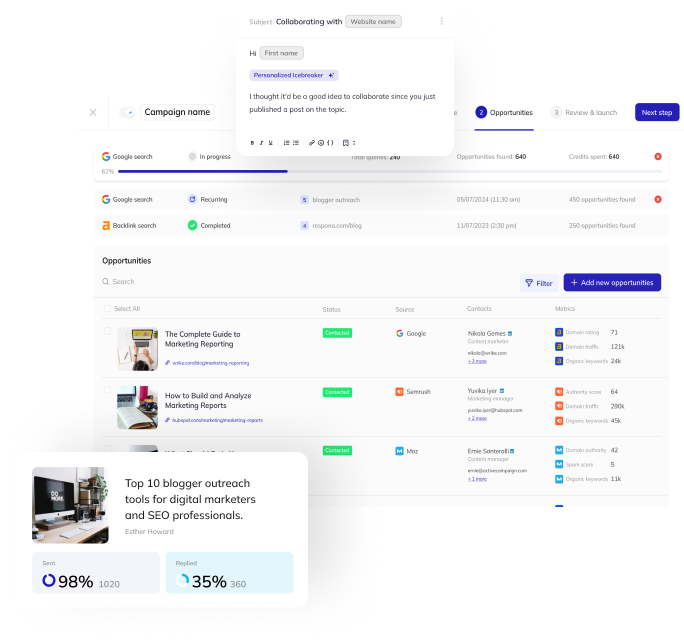Are your follow up emails falling on deaf ears?
If so, you’re not alone.
But don’t worry, we’ve got the best practices for follow up emails in 2024 – so you can start getting the response you want.
With just a few tweaks to your email subject line, context, and call-to-action, you can start connecting with your recipients and making progress.
Plus, we’ve got several email examples templates for you to use right away.
So, get ready to rock those follow up emails!
Link building cheat sheet
What is a Follow Up Email?
A follow-up email is the digital version of knocking on a door and asking “are you there?”.
It’s the polite way of saying “Hey, I’m still here and I’m wondering if you had a chance to look at my message yet.”
It’s like a friendly reminder that lets the recipient know that you’re still interested in hearing back.
In other words, it’s your way of making sure your message didn’t get lost in the digital abyss.
Follow-up emails get a bad rep for being misused by junior outreach personnel and inexperienced sales rep teams, but when done well, they can dramatically increase your open and response rate, regardless of the type of email campaign you’re running.
This brings us to the next section.
Why Should You Follow Up?
Follow-ups are the extra little something to make sure your message gets through and that the recipient understands the importance of what you’re saying.
Plus, they can help foster a positive relationship and ensure your requests don’t fall through the cracks.
In fact, according to a study by Woodpecker, a single follow-up can bring your reply rate from 9% to 14%.
That’s huge for all types of cold outreach – from email marketing to sales email outreach, getting a hold of people after a networking event, or even customer service.
For example, let’s say you sent an email to a potential employer asking for an interview.
A good idea would be to send a follow-up email a few days later to make sure the hiring manager received your message and to remind them of why you’d be a great addition to their team.
Or maybe you’re in the middle of a business negotiation and you’ve been waiting to hear back from the other party.
A follow-up email can be a great way to break the stalemate and help move the conversation forward.
Or, you have been building backlinks with a few partners but one of them simply forgot to get back to you.
It happens all of the time. We forget things too. Reminding us about it is fine.
When Should You Follow Up?
When it comes to follow up emails, timing is key. It’s important to consider both the recipient and the context when deciding when to send an email follow up.
Generally speaking, you should wait at least three business days after sending your initial email before you follow up.
This gives the recipient adequate time to review and respond to your initial message.
If you don’t hear back from the recipient after three business days, it’s perfectly acceptable to reach out with a gentle reminder.
Mention that you sent a previous message and that you were hoping to hear back about the issue.
It’s important to remain polite and professional in your follow up email, and never come off as pushy.
At the same time, you don’t want to wait too long to follow up, as this can make it seem like you don’t care about their response. If you don’t hear back from the recipient after a week, it’s reasonable to send one final follow up message.
Remember, when it comes to follow up emails, the key is to be polite and persistent!
How Many Times Should You Follow Up?
If you’re sending a follow-up email, it’s important to be persistent but not to the point of being annoying.
According to the study by Woodpecker that we referenced earlier, 2-3 follow-ups is the most optimal number to send.
You want to make sure you’re coming across as professional and not desperate. I’d suggest sending one or two follow-up emails.
The first follow-up email should be sent about a week after the initial contact. This gives the recipient time to consider your offer without feeling like you’re rushing them.
The second follow-up should be sent a few days after that if you still haven’t received a response.
At this point, you may want to consider re-framing your offer to make it more appealing.
If you still don’t get a response, the third follow-up cold email should be sent a few days after that.
This will be your last follow-up and should be clear that you won’t be contacting them again.
If there’s still silence instead of an answer, rest assured that they are not interested in whatever it is you’re pitching.
How to Write a Killer Follow-Up Email
Now, let’s take a look at the specific pieces that make a great follow-up email that elicits a response.
We won’t be talking about the obvious stuff like the greetings and sign-off along with an email signature – instead, we’ll focus on what actually matters.
Same Thread vs New Thread
First off, you should decide how you’re going to send your follow-up: in the same email thread or a separate one.
Each approach has its own distinct advantages and disadvantages.
The advantage of sending a follow-up email in the same thread is that it keeps all the related conversations together, making it easier for the recipient to refer back to the original topic.
It also helps the recipient remember the context of the conversation, which is helpful for those who get a lot of emails.
On the other hand, sending a separate follow-up email can be beneficial in the sense that it allows you to start fresh and make a more concise point without having to wade through the entire thread.
It also sets the stage for a more focused conversation, which can help the recipient better understand your message.
Ultimately, it comes down to personal preference, as both are valid options – although we prefer the same-thread approach.
Be Brief
Being brief in your follow-up email is important for a few reasons. First, it allows you to get to the point quickly and efficiently.
This is especially important if your recipient has limited time to read your message. Being brief also allows you to be more organized, as you can clearly and concisely explain what you need or want.
Finally, being brief can create a sense of professionalism and respect for your recipient’s time.
Focus on the core message you are trying to convey without getting too wordy. Use simple, straightforward language and avoid using long words or phrases.
If you can, try to add a bit of humor or wit to your message to make it more engaging and memorable.
Leverage FOMO
FOMO, or the Fear of Missing Out, is a powerful emotion that can be leveraged in follow-up emails to motivate readers to take action.
It’s important to note that FOMO should be used judiciously to avoid coming across as overly aggressive or pushy.
When used properly, FOMO can help your follow-up emails stand out from the competition and increase the chance of a response.
Here are a few examples of how to use FOMO:
- Remind them of a limited-time offer
If your email is about a limited-time offer or promotion, remind the reader of the short window of time they have left to take advantage of it. Be sure to keep the tone light and friendly, avoiding any sense of urgency or pressure.
- Highlight the benefits of taking action
Showcase the positive outcomes of taking the desired action, such as exclusive access to content, discounts, or special offers. Use a conversational and upbeat tone to make the reader feel comfortable in taking the desired action.
- Acknowledge their hesitation
Let the reader know that you understand their hesitation and are aware of the risks involved. Make them feel comfortable in taking action by addressing their concerns in a witty way.
By leveraging FOMO in a clever and witty way, you can increase the chances of your follow-up emails being read and acted upon.
But don’t overdo it!
A good example would be mentioning that you’re about to submit your guest post to another website, and if the person still wants to pull through with your link building collaboration, it may be their final chance to include their link in your content.
Extra Incentive
Adding an extra incentive to your follow-up emails is a great way to increase customer success and engagement, boost customer loyalty, and encourage more sales.
It not only shows a potential customer that you’re looking out for their best interests, but it also helps to build a stronger relationship with them.
For sales emails, an extra incentive could be offering a discount on a certain item or a special offer for a particular product.
For example, you could write something like, “Thank you for your interest in our product! As a special bonus, we’d like to offer you 10% off on your next purchase.”
For other types of business emails, you could include an extra incentive such as a free consultation, a bonus item, or a free trial.
For example, you could write something like, “Thank you for your interest in our services. As a special bonus, we’d like to offer you a free 15-minute consultation to discuss how we can best help you.”
Including an extra incentive in your follow-up emails is a great way to show your customers that you value their business.
Also, you need to keep in mind that your follow-up is probably not the only one that they receive on any given day, so you need any extra “hooks” to elicit a response as you can get.
Connect on Social Media
Connecting with your email recipient on social media while sending a follow-up email is a great way to increase your success rate.
It allows you to build a more personal connection with the recipient and adds a layer of authenticity to your message. Plus, it gives you an opportunity to continue the conversation in a more relaxed and informal manner.
Social media allows you to be creative with your words and even use GIFs or memes to add a bit of humor to your message.
But the main purpose of sending a connection request along with an email is to attach your face to your name in the memory of your prospect or potential client, making you just that little bit less of a stranger to them, while providing social proof about you and your company.
Use Automation
Manual follow-ups are tedious and impractical.
Respona automates the email outreach process completely – from prospecting to crafting personalized emails and email tracking.
And, of course, follow-ups are part of it.
With Respona, you can send custom delays, and choose between several sending strategies including no-reply (only send a message to the next person within the same company if the first one doesn’t reply), send-all, bounce, and CC.
How NOT to Follow Up
In order to truly understand what makes a great follow-up email, let’s dissect some bad ones.
The first thing you’ll undoubtedly notice about this email is the big old spam banner.
This is likely because the original message contained the words “paid collaboration”, and listed out prices for a bunch of websites.
Huge red flag.
We don’t participate in any paid collaborations, so this pitch is completely irrelevant to every employee at our company.
This follow-up was also sent just two days after the original email. Too soon.
And can you guess what day of the week it was? Sunday. So, I would never have responded to this person even if it wasn’t in my spam foder. And neither would you.
Now, let’s take a look at the actual words they have used in an attempt to reach me.
“I know you must be very busy.” – Yeah, same. I’m also enjoying my Sunday.
“Just following up to see if you got some time to look at our previous email.”
The phrase “just following up” is extremely overused and rolls quite a few eyes when seen in an email.
The same goes for the second half of that sentence. No, I didn’t have the time to look at your previous email.
And even if I did, I chose not to reply. Don’t bother me again.
This may seem a bit rude, but these are the honest thoughts that have crossed the minds of every single person that has been reached out to in a similar way.
But this isn’t the end of it.
The next day I got another follow-up from this person.
“I was hoping to get a response from your end”. And I was hoping you would stop spamming me, except I didn’t email you sending that.
So, don’t be that person. To sum it up:
- Make sure what you’re pitching the right person and check for spam words
- Don’t follow-up on weekends or other times when your prospect is inactive
- Give your prospects at least 3 business days between each follow-up
- Only follow up when necessary
- Make sure the actual wording of your emails isn’t generic
Now, let’s take a look at some good follow-up email templates for various types of business communications.
9 Follow Up Email Templates for Different Purposes
Link Building Follow-Up Email Template
Hey {first_name},
I hope this email finds you doing great! Just checking in to see if you’d be interested in adding [Your Post/Company/Product] to your {url_title} post: {url}
We’d be more than thrilled to share your updated post with our social media followers!
Let me know what you think!
Cheers,
[Your name]
Content Promotion Follow Up Email Template
Hey {first_name},
I hope you’re having a great day! Just wanted to make sure you didn’t miss my email below. We think our article [hyperlink to your post] would be a great addition to your [topic] post, and we’ve got a few more [topics] that would be a great fit for your blog.
In particular, [hyperlink to your post] could be the missing piece of your [prospects’ blog post]. What do you think?
I’m looking forward to hearing your thoughts!
Cheers,
[Your name]
Brand Pitch Follow-Up Emai Template
Hi {first_name},
I hope you’ve been doing great!
I think a collaboration between us would be a great thing, and I’m confident that, together, we could make some awesome stuff happen.
I’ve been checking out your [product/service] on [Google, social media, website], and I really think I can help you out with [what you offer].
So, if you’re interested in talking about how we can join forces and do awesome things, please let me know!
[Your name]
Guest Blogging Follow-Up Email Template
Subject: Re: Original Subject
Hi {first_name},
We hope you’ve been keeping busy!
Just reaching out to see if you’d had a chance to check out the list of topics we sent over last week.
[link to sample list]
We think adding some of these topics to your blog would really help build up your reader base.
So, if you’re swamped and need a break from the pen, we’d be more than happy to take over for you! Guest posting for you would be our pleasure!
Let us know what you think!
[Your name]
PR Outreach Follow-Up Email Template
Subject: Re: Original Subject
Hi {first_name},
I’m sure you’ve got a ton of stuff going on right now, but I didn’t want you to miss out on [reason for reaching out]. We won’t be reaching out to [Prospect’s competitors – other blogs or media publications] until [date and time], so I thought I’d give you a heads-up.
Let me know if you’re interested and I’ll send over our [landing pages or other assets] before they hit the internet!
I can’t wait to hear your thoughts.
Cheers,
[Your name]
Press Release Distribution Follow-Up Email Template
Subject: Re: Original Subject
Hi {first_name},
I’m giving you a little nudge to remind you about my previous email – I’m sure your expertise in [reason for reaching out] is just what we need!
We’ve got all the facts and figures ready for you regarding our [launch/news], and we’ve put it all together in a neat file. It’s all yours if you follow the link below:
[file link]
But don’t dilly-dally – the file will be available until [date and time] only!
Let me know if you have any questions, I’m all ears.
Cheers,
[Your name]
Job Interview Follow-Up Email Template
Subject: Re: Original Subject
Hi [Name],
It was great meeting with you today and discussing [Company] and the [Position] role. I was particularly impressed with the [Company Value] you outlined, and I am confident that my experience and skills would be an asset to the team.
I’m looking forward to continuing the conversation and learning more about the role. I’m confident that I would be an excellent fit for the position, and I’m excited for the opportunity to join the [Company] team.
I’ll be keeping my eye on my inbox, and if you have any questions or need any additional information, feel free to reach out.
Thanks again for your time,
[Your Name]
Sales Follow-Up Email Template
Subject: Re: Original Subject
Hi [Name],
Hope this message finds you well. I know it’s been a while since we last talked, but I wanted to check in and see how you’re getting along with [product/service].
I know that life can be hectic, so if you’ve been too busy to check it out, let me give you a refresher. [Product/Service] is the perfect complement to [business need], and I think it could be a great fit for your team.
I’d love to schedule a call to discuss the details and answer any questions you may have. Sound good? Let me know when you’re available and we can set something up.
Cheers,
[Your Name]
Networking Follow-Up Email Template
Subject: Re: Original Subject
Hi [Name],
It was a pleasure meeting you at [Event]! I really enjoyed our conversation about [Topic], and I’m glad to see that we both share a passion for [Topic].
I hope you found the event beneficial and that you were able to make some valuable connections. I’m sure you’re busy, so I’ll keep this one short.
Let’s keep in touch and continue our conversation! I’d love to hear more about [Topic] and the work you’re doing.
All the best,
[Your Name]
Link building cheat sheet
Wrapping Up
At the end of the day, it all boils down to this: Following up is an essential component of any successful outreach and sales process.
But what’s the key to success?
The answer is simple: automation.
With a tool like Respona, you can easily automate your follow-up process and increase your response rates exponentially. So why not give Respona a try and see the difference for yourself?
Start your 7-day free trial today and see what you’re missing out on!
Frequently Asked Questions (FAQ)
How often should I send an email follow-up?
Give your prospects at least 3 business days in between each message to avoid spamming and seeming pushy.
What’s the best way to write an effective email follow-up?
Be direct and to the point. Keep the email short and sweet, but don’t forget to be polite and friendly. Most importantly, take the time to make sure you’ve accurately conveyed the message you wanted to get across.
Is it okay to send multiple follow-up emails?
It is okay to send multiple follow-ups (up to 3), as long as they’re relevant, and spaced out over the course of a couple of weeks.
What should I include in my email follow-up?
A friendly, polite reminder that you’re looking forward to hearing back, including a link to the original message or document you sent and a clear call to action – such as a request for a response or specific next steps.
How long should I wait before sending a follow-up email?
At least three business days.








